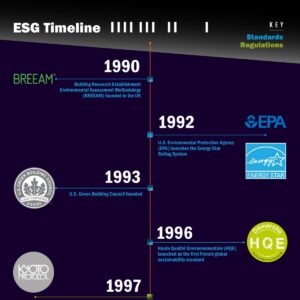“Claire, how much do you know about ESG? After our last stakeholder meeting, it was made abundantly clear that we simply cannot put it off any longer. Our investors are just short of demanding it.”
Later that day, Claire sat at her desk, replaying her earlier conversation over and over in her head.
I know it’s new to all of us…but I also know you are the best person to get us where we need to be. Claire, we’ve chosen you to spearhead our ESG initiative.”
Of course, she had responded to the V.P.’s request with her usual enthusiastic grin, but on the inside her stomach was in knots.
Wow, what an opportunity, she thought. I’ve got to get this right—it’s a big deal. But let’s be honest, I know about as much on ESG as anyone—which isn’t very much!
A quick online search gave her a little more background on ESG but mostly served to confuse her further. Claire’s eyes glazed over as she read article after article on ESG investing, scoring, frameworks, certifications, reporting, regulations…it was downright intimidating. And she still wasn’t sure how it all tied into the uniqueness of her company.
This is more complex than I realized. It seems like there’s so many different angles we could go in. What’s the best strategy for us? she wondered. And where do I start?
—
Sound familiar?
ESG may possibly be the latest business buzzword—it’s all over the news, and quickly gaining attention from investors and stakeholders. Sure, it stands for Environmental, Social and Governance. And we often hear it used short-hand to denote various wide-reaching issues such as social responsibility, keeping stakeholders happy, respecting the environment, and so on. Yet many of us are still uncertain what ESG really is, what it entails, and how to implement it successfully at our organization.
We ask: What does ESG look like for my business? What value does it bring? How do we approach it in a smart and thoughtful way?
In this article, we aim to clarify some of the ambiguity surrounding ESG and break it down in simple language, with real-life examples.
These real-life examples have emerged from our partnership with a client of ours, Health First. Health First is a privately-held community health system that serves as Central Florida’s only fully integrated delivery network (IDN).
In 2022, Health First engaged the team of development and construction consultants at The Concord Group (Concord) to provide Owner’s Representation and Program Management services for their newest capital program. Early on in the project, it became clear that sustainability measures and ESG planning also needed to be factored into the scope.
As a result, the team at Concord partnered with Epsten Group and AEI Consultants to form a Sustainability Council. This Council has a unique advantage of leveraging the diverse experience and talent of three firms working together to deliver innovative ESG and sustainability consulting solutions to capital projects. WORK WITH US.
Okay, so let’s dive in.
First of all, what is ESG?
As mentioned, ESG is an acronym that stands for Environmental, Social, and Governance. It is an umbrella term that encompasses a broad set of issues—sustainability, environmental impacts, social responsibility, labor practices, stakeholder management, community involvement, transparency, and corporate corruption, to name a few.
In practice, an effective ESG initiative examines a company’s environmental, social, and governance practices and then looks at their corresponding impacts. Next comes planning, measuring progress against benchmarks, and reporting on ESG factors.
In the case of our client, Health First, who owns numerous assets and is currently building a new facility in Florida, our Council first performed a feasibility study in order to determine the scope of the project and identify the best ways to tackle its ESG approach while working in harmony with the owner’s project requirements. Through a forward-thinking lens, we asked ourselves—what has happened to this organization in the past? How will it be impacted in the future?
Then it was on to data collection, setting targets and benchmarking, planning, implementation, third-party certifications, and ESG scoring and reporting.
Next, let’s break down ESG into its three pillars:
Environmental. The E in ESG considers all of the environment-impacting activities of your business and how it manages environmental risks. It looks at resource consumption, waste discharge, and environmental effects. It includes considerations such as carbon footprint, waste water discharge, resource scarcity management, animal treatment, and climate risks or potential extreme weather events. Located in Florida, Health First faces risks from future extreme weather events, so it was essential its ESG strategy accounted for those risks. Other environmental considerations important to Health First included understanding their carbon footprint and identifying efficiency opportunities within their facilities without jeopardizing the patient experience or their stringent compliance requirements relative to air flow and air quality. A third significant environmental concern is waste. Healthcare facilities are significant waste generators, including hazardous waste, biomedical waste, and non-risk waste including paper, cardboard, packaging, food waste, etc. As part of their ESG initiative, Health First is mapping their waste process to identify opportunities to reduce materials coming into the system and identify best ways to dispose of waste leaving the system.
Social. The S in ESG considers social criteria and examines the impact your business has on people and the broader community. This includes your relationships with employees, suppliers and customers, and your reputation within the community. It looks at working conditions and examines internal policies related to labor, health, safety, inclusion, and diversity. In our work with Health First, important social considerations revolve around the employee and patient experience, as well as the impact of their facilities on the community around them. Health First is in the early stages of considering WELL at Scale for their entire portfolio. WELL focuses on air, water, nourishment, light, fitness, comfort, and mind of the facility and how the people in the building experience the space. The alignment of WELL with the “S” in “ESG” will help advance several of Health First’s ESG goals.
Governance. The G in ESG explores how your company shows compliance and transparency of your corporate operations. It examines the practices, policies and procedures your company assumes in order to meet the needs of stakeholders and comply with government regulations. In regards to Health First, important leadership considerations include the development of policies and standard operating procedures supporting their ESG objectives. This impacts all aspects of the business including organizational management, their existing assets, and new development.
Doing business differently
When clients ask us, what is ESG?, it often makes sense to start out by explaining it from a broad perspective. Broadly speaking, ESG can be viewed as a movement or a different approach to doing business. It represents a shift in the way we think about doing business today. The purpose of this movement is to make sure organizations account not only for their profit margins, but also the impacts they have on the world and on society.
The ESG movement demonstrates how we can work together to do business in a way that is better for our planet, our people, and our communities, while still achieving profitability goals. Rather than focusing on short-term gains, ESG is a form of risk management that requires a commitment to the long-term. Inspecting our business through a forward-thinking lens enables us to prepare for future uncertainties and support more sustainable, long-term wealth creation.
ESG compels us to scrutinize our businesses in a holistic way, connecting the environment we live in with social factors and good governance. When considering ESG, we ask ourselves questions such as:
- To what degree are we managing our carbon footprint?
- What are we doing to enhance diversity and inclusion in our labor practices?
- How are we supporting the community in which we do business?
- To what degree our we transparent in our business operations and reporting?
- What are we doing to plan for the future and support our long-term viability?
- What are we doing to retain our stakeholders and acquire new investors?
Want to learn more? Stay tuned for Segment 2: The History of ESG.
Authors:
Karla L. King, Executive Vice President, Sustainability & Resiliency, AEI Consultants
Karla, Executive Vice President of Sustainability and Resiliency at AEI Consultants, is both an environmental engineer and an attorney specializing in navigating sustainability and regulatory compliance to ensure business continuity and operational objectives. Karla is focusing on sustainable solutions with clients as they focus on Environment, Social, Governance (ESG), climate resiliency, and net zero objectives. Karla holds a BS in Civil/Environmental Engineering from Northeastern University, a MS in Engineering Management from Tufts University, and a JD from Massachusetts School of Law. She is a Professional Engineer licensed in MA, CT, RI, VT, NH, ME, NY, and NC, as well as a LEED Accredited Professional.
Mike Lodge, Director of Technical Services, The Concord Group
With more than 35 years of experience in the building services industry, Mike has supported many higher education, mission critical, healthcare, K-12, commercial, industrial and pharma/biotech facilities both domestically and internationally.
In his role as Director of Technical Services, Mike is responsible for building and supporting these service offerings throughout the US and Internationally. His experience in operations management, commissioning, project management, field testing and operations and maintenance allows him to fill multiple roles on any project team. He is focused on providing clients with fully operational facilities, well trained staff, identifying potential utility savings with the mechanical systems and providing a comfortable building environment.
Having grown up in England, Mike enjoys returning home on a regular basis to spend time with his family and friends.
Lauren M. Wallace, Principal, Director of Certifications and Consulting, Epsten Group
Joining Epsten Group in 2009 as an Architectural Designer, Lauren is now a Principal and the Director of Certifications and Consulting. She is a leading sustainability consultant who cares about incorporating sustainable practices throughout the design-build industry. Aligning with the firm’s beliefs, Lauren’s work demonstrates that planning for the long-term can truly pay-off for a project. By working alongside her to integrate widespread sustainability practices, her clients can save time and money, and equally important, attract and retain much-needed talent. Along with her incredibly talented team, she helps uncover the possibilities.
Marianna Moores, Senior Manager, ESG, Epsten Group
Marianna has over 15 years of experience in the sustainability industry, working with owners, operators, and tenants to reach their environmental goals at both the project and organization level. She holds both a BS in Architecture and an MBA in Management of Technology: Global Business from Georgia Institute of Technology. Marianna has served as a consultant on a wide range of asset types including office buildings, corporate interiors, hotels, schools, convention centers, parks, retail, data center, and healthcare. She has extensive experience in LEED and SITES certifications, WELL portfolio management, and corporate sustainability implementation. She is also an experienced certifications reviewer. Marianna specializes in ESG bridge services and multiple certification portfolio management.



